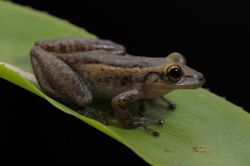Biology:Scinax tymbamirim
| Scinax tymbamirim | |
|---|---|

| |
| Scientific classification | |
| Domain: | Eukaryota |
| Kingdom: | Animalia |
| Phylum: | Chordata |
| Class: | Amphibia |
| Order: | Anura |
| Family: | Hylidae |
| Genus: | Scinax |
| Species: | S. tymbamirim
|
| Binomial name | |
| Scinax tymbamirim Nunes, Kwet, and Pombal, 2012
| |
| Synonyms[1] | |
| |
Scinax tymbamirim is a frog in the family Hylidae. It is endemic to Brazil .[2][3][1]
Appearance
The adult male frog is 20.6 to 27.4 mm long in snout-vent length and the adult female frog 22.3 to 31.2 mm.[1]
This frog is brown or orange-brown in color on the dorsum. It has interrupted white stripes down its sides. There is a five-sided intraocular mark, lined with yellow. There are dark brown bars across all the front and hind legs. Its ventrum is beige in color. This frog has vomerine teeth in its jaw. It has disks on its toes for climbing.[1]
Home
This frog lives in coastal lowlands up to hills and highlands 1000 meters above sea level.[2]
Name
The scientific name of this frog comes from the Tupí-guarani language. Tymba means "animal" and mirim means "small." The scientists named this frog "small animal" because it is smaller that Scinax alter.[1]
References
- ↑ 1.0 1.1 1.2 1.3 1.4 Nunes I; Kwet A; Pombal Jr JP (2012). "Taxonomic revision of the Scinax alter species complex (Anura: Hylidae).". Copeia 2012 (3): 554–569. doi:10.1643/CH-11-088. http://www.herpetologiamuseunacional.com.br/Pombal/pdf/2012_Nunes_etal_Revision_Scinax_alter_complex.pdf. Retrieved May 26, 2022.
- ↑ 2.0 2.1 Frost, Darrel R.. "Scinax tymbamirim Nunes, Kwet, and Pombal, 2012". American Museum of Natural History, New York. https://amphibiansoftheworld.amnh.org/Amphibia/Anura/Hylidae/Scinaxinae/Scinax/Scinax-tymbamirim.
- ↑ "Scinax tymbamirim". University of California, Berkeley. https://amphibiaweb.org/species/7913.
Wikidata ☰ Q3475843 entry
 |

